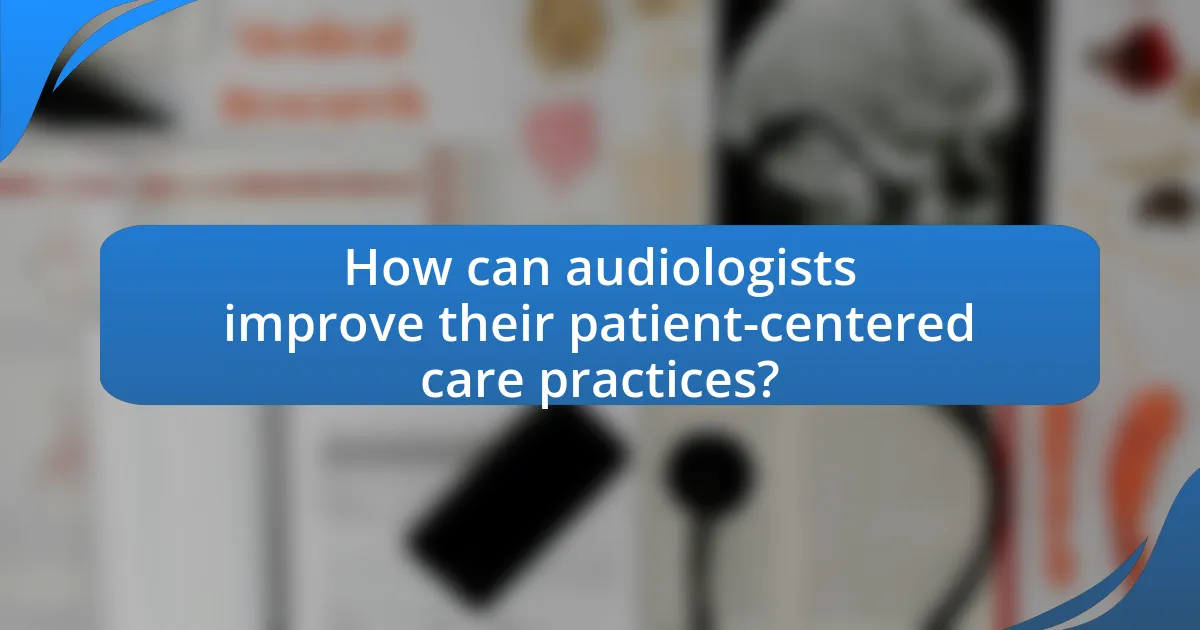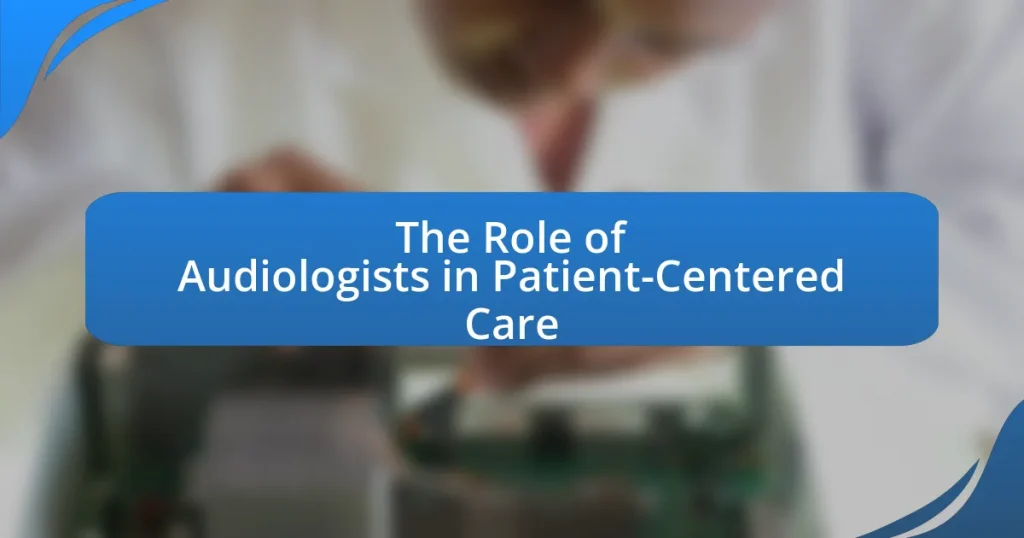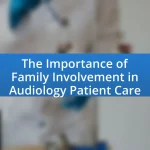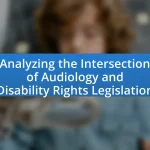Audiologists are essential healthcare professionals who specialize in assessing, diagnosing, and managing hearing and balance disorders while prioritizing patient-centered care. This article explores the significant role audiologists play in enhancing patient satisfaction and health outcomes through personalized treatment plans, effective communication, and active patient involvement. Key components of patient-centered care in audiology include individualized assessments, ongoing support, and the integration of technology to improve patient experiences. Additionally, the article addresses the challenges audiologists face in implementing these practices and offers practical tips for enhancing patient engagement and adherence to treatment recommendations.

What is the Role of Audiologists in Patient-Centered Care?
Audiologists play a crucial role in patient-centered care by assessing, diagnosing, and managing hearing and balance disorders while prioritizing the individual needs and preferences of patients. They engage in active listening to understand patients’ concerns, provide personalized treatment plans, and educate patients about their conditions and available options. Research indicates that patient-centered approaches in audiology lead to improved patient satisfaction and better health outcomes, as evidenced by a study published in the Journal of the American Academy of Audiology, which found that patients who felt involved in their care reported higher levels of adherence to treatment recommendations.
How do audiologists contribute to patient-centered care?
Audiologists contribute to patient-centered care by actively involving patients in their hearing health decisions and tailoring interventions to meet individual needs. They conduct comprehensive assessments to understand each patient’s unique hearing challenges and preferences, ensuring that treatment plans are personalized. Research indicates that patient-centered approaches in audiology lead to improved satisfaction and outcomes, as patients feel more empowered and engaged in their care process.
What specific skills do audiologists bring to patient interactions?
Audiologists bring essential skills to patient interactions, including effective communication, empathy, and clinical expertise. Effective communication allows audiologists to explain complex auditory concepts in understandable terms, ensuring patients grasp their conditions and treatment options. Empathy enables audiologists to connect with patients on a personal level, fostering trust and comfort during assessments and consultations. Clinical expertise, grounded in extensive training and knowledge of hearing disorders, equips audiologists to conduct thorough evaluations and recommend appropriate interventions. These skills collectively enhance the patient experience and promote better health outcomes in audiology care.
How do audiologists assess patient needs in a patient-centered approach?
Audiologists assess patient needs in a patient-centered approach by conducting comprehensive evaluations that prioritize the individual experiences and preferences of each patient. This process typically involves detailed case history interviews, standardized questionnaires, and audiometric testing to gather information about the patient’s hearing abilities, communication challenges, and lifestyle factors.
Furthermore, audiologists engage in active listening and empathetic communication to understand the patient’s concerns and goals, ensuring that the care plan aligns with their specific needs. Research indicates that patient-centered care improves satisfaction and outcomes, as evidenced by studies showing that patients who are actively involved in their care decisions report higher levels of adherence to treatment and better overall health outcomes.
Why is patient-centered care important in audiology?
Patient-centered care is important in audiology because it enhances patient satisfaction and outcomes by prioritizing individual needs and preferences. This approach allows audiologists to tailor interventions, such as hearing aids or rehabilitation programs, to fit the unique circumstances of each patient, leading to better adherence and improved quality of life. Research indicates that patient-centered practices in healthcare can lead to a 30% increase in patient satisfaction and a 20% improvement in health outcomes, demonstrating the effectiveness of this model in audiology.
What are the benefits of patient-centered care for audiology patients?
Patient-centered care for audiology patients enhances treatment outcomes and patient satisfaction. This approach prioritizes the individual needs and preferences of patients, leading to improved adherence to treatment plans and better communication between audiologists and patients. Research indicates that patient-centered care can result in a 30% increase in patient satisfaction scores and a 20% improvement in treatment adherence, as patients feel more engaged and valued in their care process. By fostering a collaborative environment, audiologists can tailor interventions more effectively, ultimately leading to better hearing health outcomes.
How does patient-centered care improve treatment outcomes in audiology?
Patient-centered care improves treatment outcomes in audiology by fostering a collaborative relationship between audiologists and patients, which enhances adherence to treatment plans. This approach allows audiologists to tailor interventions based on individual patient needs, preferences, and values, leading to increased satisfaction and better management of hearing loss. Research indicates that when patients are actively involved in their care decisions, they are more likely to follow through with recommended treatments, resulting in improved hearing function and overall quality of life. For instance, a study published in the Journal of the American Academy of Audiology found that patient engagement in care processes significantly correlated with positive audiological outcomes, demonstrating the effectiveness of patient-centered strategies in audiology.

What are the key components of patient-centered care in audiology?
The key components of patient-centered care in audiology include effective communication, individualized treatment plans, active patient involvement, and ongoing support. Effective communication ensures that audiologists understand patients’ needs and preferences, fostering a trusting relationship. Individualized treatment plans are tailored to each patient’s unique hearing challenges and lifestyle, enhancing the relevance and effectiveness of interventions. Active patient involvement encourages patients to participate in decision-making regarding their care, which has been shown to improve satisfaction and outcomes. Ongoing support, including follow-up appointments and resources, helps patients adapt to their hearing devices and maintain their hearing health over time. These components collectively contribute to a holistic approach that prioritizes the patient’s experience and outcomes in audiology care.
How do audiologists engage patients in their care process?
Audiologists engage patients in their care process by actively involving them in decision-making and treatment planning. They utilize effective communication strategies, such as explaining test results clearly and discussing various treatment options, which empowers patients to make informed choices about their hearing health. Research indicates that patient engagement leads to better health outcomes; for instance, a study published in the Journal of the American Academy of Audiology found that patients who participated in their care reported higher satisfaction levels and adherence to treatment plans. By fostering a collaborative environment, audiologists enhance the overall patient experience and promote better management of hearing-related issues.
What techniques do audiologists use to foster patient communication?
Audiologists use several techniques to foster patient communication, including active listening, clear verbal explanations, and the use of visual aids. Active listening allows audiologists to fully understand patient concerns and preferences, which enhances the therapeutic relationship. Clear verbal explanations help patients comprehend their hearing conditions and treatment options, ensuring informed decision-making. Visual aids, such as diagrams and charts, support understanding by providing concrete representations of complex information. These techniques are essential in promoting effective communication, which is a cornerstone of patient-centered care in audiology.
How do audiologists incorporate patient feedback into their practice?
Audiologists incorporate patient feedback into their practice by actively soliciting input during consultations and follow-up appointments. They utilize surveys, interviews, and informal discussions to gather insights on patient experiences, preferences, and satisfaction levels. This feedback is then analyzed to identify trends and areas for improvement, allowing audiologists to tailor their services and interventions to better meet individual patient needs. Research indicates that practices that integrate patient feedback can enhance treatment outcomes and patient satisfaction, as evidenced by a study published in the Journal of the American Academy of Audiology, which found that patient-centered approaches significantly improved adherence to hearing aid use.
What role does technology play in patient-centered audiology care?
Technology plays a crucial role in patient-centered audiology care by enhancing diagnostic accuracy and personalizing treatment options. Advanced audiological devices, such as digital hearing aids and cochlear implants, utilize sophisticated algorithms to adapt to individual patient needs, improving hearing outcomes. Additionally, tele-audiology platforms facilitate remote consultations, allowing audiologists to provide care and support to patients regardless of geographical barriers. Research indicates that the integration of technology in audiology not only increases patient engagement but also leads to higher satisfaction rates, as evidenced by a study published in the Journal of the American Academy of Audiology, which found that 85% of patients reported improved communication abilities with the use of modern hearing technology.
How do audiologists utilize technology to enhance patient experiences?
Audiologists utilize technology to enhance patient experiences by implementing advanced diagnostic tools, personalized hearing aids, and telehealth services. Advanced diagnostic tools, such as real-ear measurement systems and automated audiometers, allow audiologists to obtain precise assessments of hearing loss, leading to tailored treatment plans. Personalized hearing aids equipped with features like Bluetooth connectivity and smartphone compatibility enable patients to have a more customized listening experience, improving their overall satisfaction. Additionally, telehealth services facilitate remote consultations, making it easier for patients to access care and follow-up appointments, which has been shown to increase patient engagement and adherence to treatment plans.
What are the challenges of integrating technology in patient-centered care?
Integrating technology in patient-centered care presents several challenges, including issues related to data privacy, interoperability, and the digital divide. Data privacy concerns arise as sensitive patient information is shared across platforms, leading to potential breaches. Interoperability challenges occur when different healthcare systems and technologies cannot effectively communicate, hindering seamless care coordination. Additionally, the digital divide affects access to technology, particularly for underserved populations, which can exacerbate health disparities. These challenges highlight the need for robust solutions to ensure that technology enhances rather than hinders patient-centered care.

How can audiologists improve their patient-centered care practices?
Audiologists can improve their patient-centered care practices by actively involving patients in decision-making processes regarding their hearing health. This approach fosters a collaborative environment where patients feel valued and understood, leading to better adherence to treatment plans. Research indicates that patient engagement in healthcare decisions enhances satisfaction and outcomes, as evidenced by a study published in the Journal of the American Academy of Audiology, which found that patients who participated in shared decision-making reported higher levels of satisfaction with their care. Additionally, audiologists can utilize personalized communication strategies tailored to individual patient needs, ensuring that information is accessible and relevant. By implementing these practices, audiologists can significantly enhance the quality of care they provide.
What training and education do audiologists need for effective patient-centered care?
Audiologists require a Doctor of Audiology (Au.D.) degree, which includes extensive training in communication disorders, hearing science, and patient management to provide effective patient-centered care. This education typically encompasses clinical internships and hands-on experience, allowing audiologists to develop skills in assessing and treating hearing and balance disorders while focusing on the individual needs of patients. Additionally, continuing education is essential for audiologists to stay updated on advancements in technology and treatment methodologies, ensuring they can deliver the highest standard of care tailored to each patient’s unique circumstances.
How can continuing education enhance audiologists’ patient-centered skills?
Continuing education enhances audiologists’ patient-centered skills by providing updated knowledge and techniques that improve communication and empathy in patient interactions. This ongoing training equips audiologists with the latest evidence-based practices, enabling them to better understand patient needs and preferences. Research indicates that audiologists who engage in continuing education demonstrate improved patient satisfaction and outcomes, as they are more adept at tailoring interventions to individual patient circumstances. For instance, a study published in the Journal of the American Academy of Audiology found that audiologists who participated in continuing education reported higher levels of confidence in addressing patient concerns, leading to more effective care delivery.
What resources are available for audiologists to improve their practice?
Audiologists can access various resources to enhance their practice, including professional organizations, continuing education programs, and evidence-based guidelines. Organizations such as the American Speech-Language-Hearing Association (ASHA) and the Academy of Doctors of Audiology (ADA) provide valuable resources, including webinars, workshops, and networking opportunities. Continuing education programs, often accredited, allow audiologists to stay updated on the latest research and techniques, ensuring they provide high-quality care. Additionally, evidence-based guidelines from sources like the American Academy of Audiology offer frameworks for best practices in patient-centered care, helping audiologists make informed clinical decisions.
What best practices can audiologists adopt for patient-centered care?
Audiologists can adopt several best practices for patient-centered care, including active listening, personalized treatment plans, and ongoing patient education. Active listening ensures that audiologists fully understand patients’ concerns and preferences, which fosters trust and improves communication. Personalized treatment plans take into account individual patient needs, preferences, and lifestyle, leading to more effective outcomes. Ongoing patient education empowers patients by providing them with the knowledge to manage their hearing health, which has been shown to enhance patient satisfaction and adherence to treatment. These practices are supported by research indicating that patient-centered approaches lead to better health outcomes and increased patient engagement in their care.
How can audiologists create a welcoming environment for patients?
Audiologists can create a welcoming environment for patients by ensuring a comfortable and accessible clinic space. This includes using soft lighting, comfortable seating, and clear signage to guide patients. Additionally, audiologists should engage in active listening and empathetic communication, which fosters trust and rapport. Research indicates that a positive clinic atmosphere can significantly enhance patient satisfaction and compliance with treatment plans, as noted in a study published in the Journal of Audiology.
What strategies can audiologists use to build trust with their patients?
Audiologists can build trust with their patients by actively listening to their concerns and providing personalized care. Active listening demonstrates empathy and understanding, which are crucial for establishing a strong patient-provider relationship. Research indicates that effective communication, including clear explanations of procedures and outcomes, enhances patient satisfaction and trust. Additionally, involving patients in decision-making about their treatment fosters a sense of ownership and confidence in the care they receive. Studies show that when patients feel heard and respected, their adherence to treatment plans improves, further solidifying trust in their audiologist.
What are common challenges audiologists face in implementing patient-centered care?
Audiologists commonly face challenges such as time constraints, limited resources, and varying patient engagement levels when implementing patient-centered care. Time constraints often arise from the need to balance clinical responsibilities with the comprehensive communication required for patient-centered approaches. Limited resources, including access to technology and support staff, can hinder the ability to provide personalized care. Additionally, varying levels of patient engagement can complicate the implementation of tailored treatment plans, as some patients may be less proactive in their care. These challenges can impact the effectiveness of patient-centered care, as highlighted in studies showing that effective communication and resource availability are critical for successful implementation.
How can audiologists overcome barriers to effective communication with patients?
Audiologists can overcome barriers to effective communication with patients by employing active listening techniques and utilizing clear, jargon-free language. Active listening allows audiologists to fully understand patient concerns and preferences, fostering a more open dialogue. Research indicates that effective communication improves patient satisfaction and adherence to treatment plans, as evidenced by a study published in the Journal of the American Academy of Audiology, which found that patients who felt understood were more likely to follow through with recommendations. Additionally, audiologists can use visual aids and demonstrations to enhance understanding, particularly for patients with hearing loss or cognitive impairments, thereby ensuring that information is conveyed accurately and effectively.
What solutions exist for addressing patient resistance to care recommendations?
Solutions for addressing patient resistance to care recommendations include enhancing communication, building trust, and involving patients in decision-making. Effective communication involves using clear, jargon-free language to explain the benefits and necessity of care recommendations, which can help patients understand their importance. Building trust can be achieved through consistent follow-ups and demonstrating empathy, making patients feel valued and understood. Involving patients in the decision-making process empowers them, allowing them to express their concerns and preferences, which can lead to increased adherence to care recommendations. Research indicates that patient engagement strategies significantly improve compliance rates, as seen in studies published in the Journal of Patient Experience, which highlight the positive correlation between patient involvement and adherence to treatment plans.
What practical tips can audiologists apply to enhance patient-centered care?
Audiologists can enhance patient-centered care by actively involving patients in decision-making regarding their hearing health. This can be achieved through effective communication, where audiologists explain treatment options clearly and encourage patients to express their preferences and concerns. Research indicates that patient engagement leads to better health outcomes, as patients who feel heard are more likely to adhere to treatment plans. Additionally, audiologists should personalize care by considering each patient’s unique lifestyle and hearing needs, which fosters a more tailored approach to treatment. Implementing regular follow-ups and feedback sessions can also ensure that patients feel supported throughout their care journey, further solidifying the patient-centered model.


